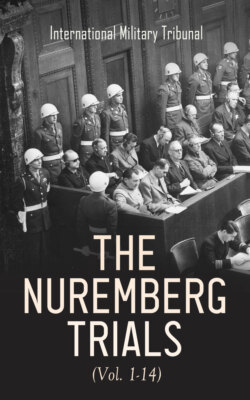Читать книгу The Nuremberg Trials (Vol. 1-14) - International Military Tribunal - Страница 48
(J) GERMANIZATION OF OCCUPIED TERRITORIES
ОглавлениеIn certain occupied territories purportedly annexed to Germany the defendants methodically and pursuant to plan endeavored to assimilate those territories politically, culturally, socially, and economically into the German Reich. The defendants endeavored to obliterate the former national character of these territories. In pursuance of these plans and endeavors, the defendants forcibly deported inhabitants who were predominantly non-German and introduced thousands of German colonists.
This plan included economic domination, physical conquest, installation of puppet governments, purported de jure annexation and enforced conscription into the German Armed Forces.
This was carried out in most of the occupied countries including: Norway, France (particularly in the Departments of Upper Rhine, Lower Rhine, Moselle, Ardennes, Aisne, Nord, Meurthe and Moselle), Luxembourg, the Soviet Union, Denmark, Belgium, and Holland.
In France in the Departments of Aisne, Nord, Meurthe and Moselle, and especially in that of Ardennes, rural properties were seized by a German state organization which tried to have them exploited under German direction; the landowners of these exploitations were dispossessed and turned into agricultural laborers.
In the Department of Upper Rhine, Lower Rhine, and Moselle, the methods of Germanization were those of annexation followed by conscription.
1. From the month of August 1940, officials who refused to take the oath of allegiance to the Reich were expelled. On 21 September expulsions and deportation of populations began and on 22 November 1940, more than 70,000 Lorrainers or Alsatians were driven into the south zone of France. From 31 July 1941 onwards, more than 100,000 persons were deported into the eastern regions of the Reich or to Poland. All the property of the deportees or expelled persons was confiscated. At the same time, 80,000 Germans coming from the Saar or from Westphalia were installed in Lorraine and 2,000 farms belonging to French people were transferred to Germans.
2. From 2 January 1942, all the young people of the Departments of Upper Rhine and Lower Rhine, aged from 10 to 18 years, were incorporated in the Hitler Youth. The same thing was done in Moselle from 4 August 1942. From 1940 all the French schools were closed, their staffs expelled, and the German school system was introduced in the three Departments.
3. On the 28 September 1940, an order applicable to the Department of Moselle ordained the Germanization of all the surnames and Christian names which were French in form. The same thing was done from 15 January 1943, in the Departments of Upper Rhine and Lower Rhine.
4. Two orders from 23 to 24 August 1942 imposed by force German nationality on French citizens.
5. On 8 May 1941, for Upper Rhine and Lower Rhine, 23 April 1941, for Moselle, orders were promulgated enforcing compulsory labor service on all French citizens of either sex aged from 17 to 25 years. From 1 January 1942 for young men and from 26 January 1942 for young girls, national labor service was effectively organized in Moselle. It was from 27 August 1942 in Upper Rhine and in Lower Rhine for young men only. The classes 1940, 1941, 1942 were called up.
6. These classes were retained in the Wehrmacht on the expiration of their time and labor service. On 19 August 1942, an order instituted compulsory military service in Moselle. On 25 August 1942, the classes 1940-44 were called up in three departments. Conscription was enforced by the German authorities in conformity with the provisions of German legislation. The first revision boards took place from 3 September 1942. Later in Upper Rhine and Lower Rhine new levies were effected everywhere on classes 1928 to 1939 inclusive. The French people who refused to obey these laws were considered as deserters and their families were deported, while their property was confiscated.
These acts violated Articles 43, 46, 55, and 56 of the Hague Regulations, 1907, the laws and customs of war, the general principles of criminal law as derived from the criminal laws of all civilized nations, the internal penal laws of the countries in which such crimes were committed, and Article 6 (b) of the Charter.
IX. Individual, group, and organization responsibility for the offense stated In Count Three
Reference is hereby made to Appendix A of this Indictment for a statement of the responsibility of the individual defendants for the offense set forth in this Count Three of the Indictment. Reference is hereby made to Appendix B of this Indictment for a statement of the responsibility of the groups and organizations named herein as criminal groups and organizations for the offense set forth in this Count Three of the Indictment.
